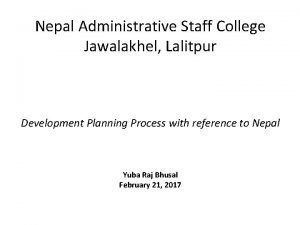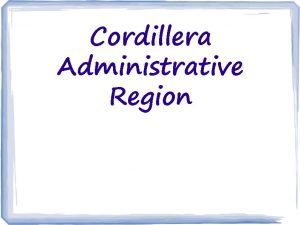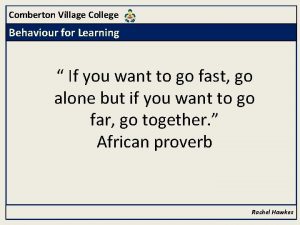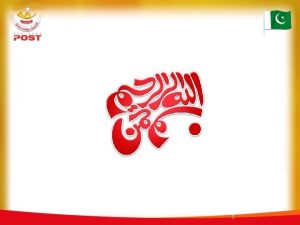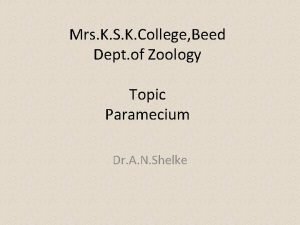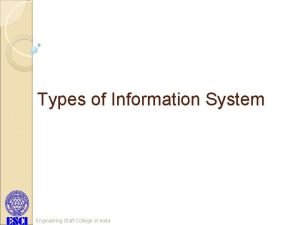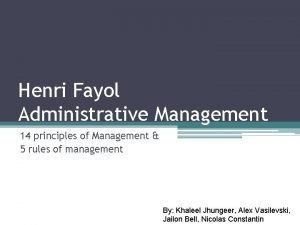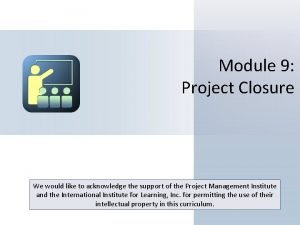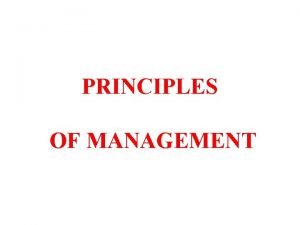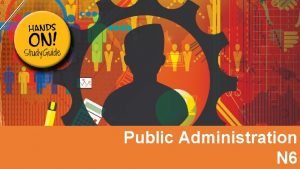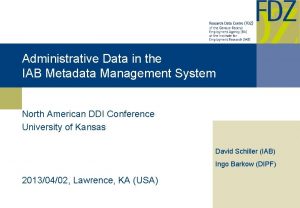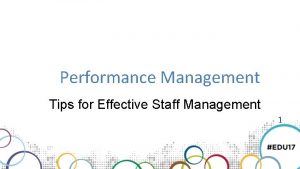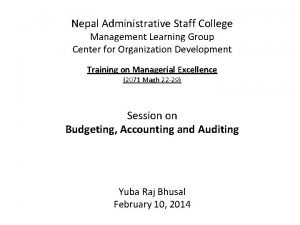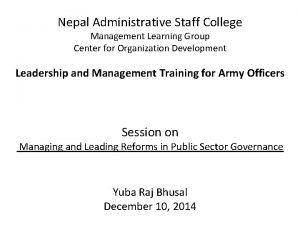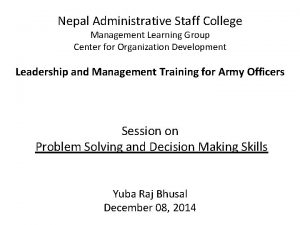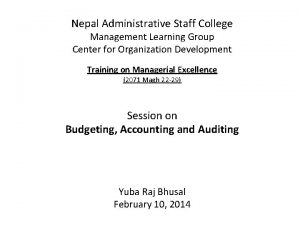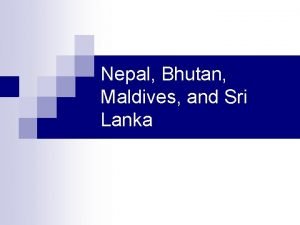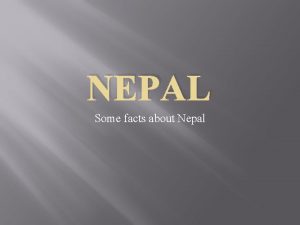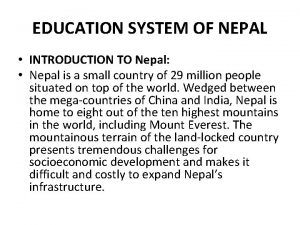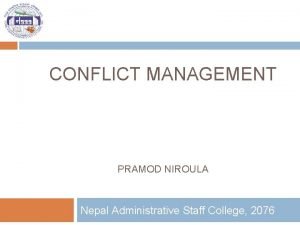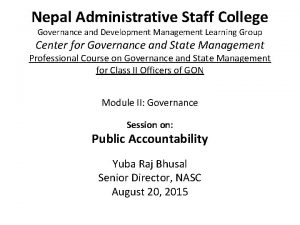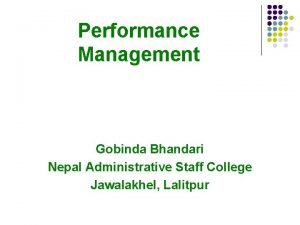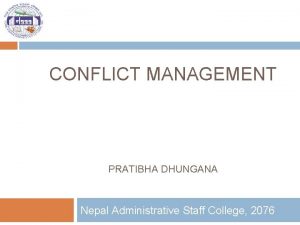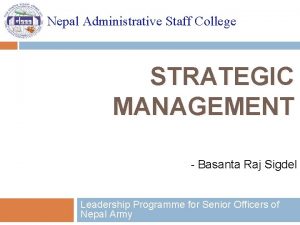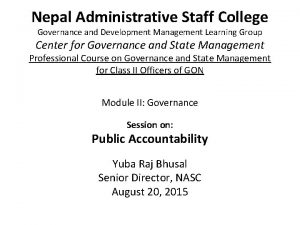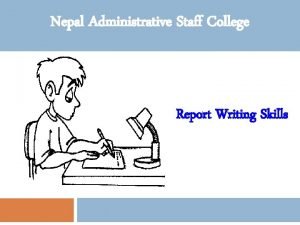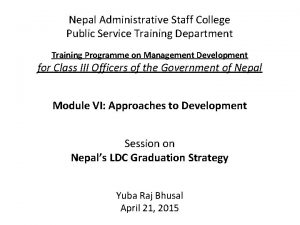Nepal Administrative Staff College Management Learning Group Center
















- Slides: 16

Nepal Administrative Staff College Management Learning Group Center for Organization Development Leadership and Management Training for Army Officers Session on Problem Solving and Decision Making Skills Yuba Raj Bhusal December 08, 2014

Table of Contents 1. Problem solving 2. Decision Making (DM) 3. Importance of DM 4. Decision Categories 5. DM process and Techniques 6. Styles of DM 7. Theories/Models of DM 8. Factors influencing DM 9. Common lapses in DM 10. Ways to improve DM ability 11. DM process & DM Problems in Nepal 12. Case Study

1. Problem solving Traditionally, it is argued that problem analysis must be done first, so that the information gathered in that process may be used for decision-making. Problem solving and decision making are recognized as central, crucial and skills of effective management. • Problem solving is the art of finding the ways to get from where you are now to where you want to be. • The problem therefore is a gap between the present situation and a more desirable situation. • Problem solving is the process of closing the gap (changing the current state into the desired one).

Problem demands what went wrong! It requires sharp observations, analysis and specific comparisons all aimed at finding a cause. Decision situation demands a statement of clear objectives and careful evaluation of alternatives all aimed at taking action. Problem solving needs techniques like analyzing (breaking into parts), synthesizing (putting together parts to make a complex whole) and valuing (thinking in relation to values and standards). Problem Decision Implementation

2. Decision Making It is a choice made between alternative courses of action in a situation of uncertainty. • A thought process of selecting a logical choice; • The study of identifying and choosing alternatives based on the values and preferences of the decision maker. • Need to weigh the consequences (positive, negative); • Forecast the outcomes of each option and choose the best one; • Importance of applying the concept of mind, wisdom and consciousness. DM is one of the central activities of the management.

3. Importance of DM • DM is a process that is interdisciplinary, systematic, information based, involving uncertainties and concerned with actions. • Each organizational entity needs decisions; • Each decision has implications both positive and negative; • DM is a key role of the Manager at different levels (individual, group, organizational, household, community, district, national and international); • Top decision makers are often high risk takers, are impatient to get rid of problems & see risk taking as their responsibility.

4. Decision categories a) Programmed: • repetitive, routine choices, proceduralized, sequential. • Presently, computer programming also available. b) Un-programmed: • Novel, unstructured & less predictable. • Complex and elusive. • Intelligence combined with adaptive solution oriented action required.

5. DM Styles a) Authoritarian: manager decides without consulting team/group & passes it down; b) Consultative: advice, co-work, coordination; c) Participatory: joint decision of a team; d) Delegative: providing authority to decide; e) Rationale/ Logical: a good DM process. Identification of problem/diagnosis, analyze the causes of the problem, develop alternatives, rate/compare the consequences of each alternative; select the best one.

6. DM Process and Techniques Define situation Choose the best Option Implement Specify Objectives, risks, and constraints Devise alternative solutions Diagnose problems Analyze the causes of Problems Compare Options a) Anticipating adverse consequences, b) Selling the decision & gaining commitment, c) Putting the plan into effect. Develop Options

The Techniques: 6 ‘C’s • Construct a clear picture what must be decided. • Compile a list of requirements that must be met. • Collect information on alternatives that meet the requirements. • Compare alternatives that meet the requirements. • Consider the ‘what might go wrong’ with each alternative. • Commit to a decision and follow through with it.

7. Theories/Models of DM Decisions can be made on following basis: • Incremental: ‘muddling through’ is pragmatic, by applying past experience in similar cases; • Rational: people make decisions by determining the likelihood of a potential outcome & the value of the outcome through a systematic analysis; • Mixed scanning: incremental and rational; • Limited rationality: humans are not all rational; • Populist: media info, conference/ workshop/seminar findings, demand of delegations; • Normative: consistency in DM across situations as per the established norms and practices; • Adaptive: situational/ a common phenomenon.

8. Factors influencing DM • Factual/distorted/conflicting/overloaded information; • Environment: External/internal (multiple and conflicting parties); • Values (personal bias) and ethics (good for individual/society); • Experience, knowledge and wisdom; • Availability of resources; • Psychological attributes (intuition/ perceptual ability, information capacity, judgment, risk taking propensity, creativity); • Technology, culture and ethics.

9. Common lapses in DM • Relying too much on expert information: need to seek info from different sources; • Under/over estimating the value of information received from the stakeholders; • Pre-conceived notion (prejudice) on the issue; • Timeliness (hurried, delayed, on time); • Lack of analysis; • Vested interest.

10. Ways to improve DM ability • Manage the flow of information from multiple sources; • Evidence-based decision; • Recognize the external/internal environment; • Improve analytical ability; • Invite conflicting views (from out of the box); • Adopt participative/rational approach; • Apply common sense; • Be value free; • Maintain neutrality (from politics); • Be ethical (difficult in business decisions); • Apply good personal traits (integrity, loyalty, trustworthy, respectful, responsible, fair, caring, civilized).

11. DM process & DM Problems in Nepal • Verbal: Especially in security, defense, immigration, revenue sectors; • Written/recorded: tok-adesh, tippani, prastab; • Lack of compilation of the precedents (previous decisions) in working-manuals/journals (in Judiciary it is maintained); • Not deciding, personal biasness, red-tapism, hassling, delaying, buck-passing/ shifting, avoiding, formalism; less ethical. • Lack of rational approach; • Oversight Agencies’ activism.

12. Case Study Mr. Ram Bahadur K. C. comes from Jajarkot district and now is working as Nayab Subba in DADO, Achham since 2066 after passing PSC exam from PSS Regional Office, Dipayel. He has already passed MPA first year (private) & appearing in the second year. His wife Sunita K. C. , from Chitwan, while studying in Kathmandu also passed PSC exam of Kharidar from PSC, Narayani Zonal Office, Hetauda in 2068 and is working at District Administration Office, Hetauda. They also have a daughter Minakshi, now studying in class 12 in St. Xavier’s College, Kathmandu after passing a competitive examination for government scholarship as she was very talented. This family wants to be together for each other’s support and career development. Mr. Ram Bahadur K. C. urged CA Members from Achham and Jajarkot for supporting him to get things done. He applies to MOGA every year from 2068 for his transfer as per the Civil Service Rule, claiming that the family has right to stay together. He also approached some leaders of Employees’ Trade Unions. He followed it several times but nothing happened in it. Please examine the problem empathetically and analyze it carefully thereafter propose to the top management with your advice for taking an appropriate decision in this problem. While doing so you have to observe the related laws and apply your experience, knowledge and skills to come up with a decision that creates a ‘win-win’ situation to all the stakeholders in this process! Thank you.
 Nepal administrative staff college
Nepal administrative staff college Scientific management and administrative management
Scientific management and administrative management The regional center of the cordillera administrative region
The regional center of the cordillera administrative region Comberton village college staff
Comberton village college staff Cornwall college staff
Cornwall college staff Eco postal staff college
Eco postal staff college Ksk college beed
Ksk college beed Ksk college beed staff
Ksk college beed staff Engineering staff college of india
Engineering staff college of india Cuadro comparativo de e-learning
Cuadro comparativo de e-learning Henri fayol administrative management
Henri fayol administrative management Administrative closure in project management
Administrative closure in project management Who is the father of management
Who is the father of management Generic functions of public administration
Generic functions of public administration Administrative data management
Administrative data management Rasic chart
Rasic chart Staff management tips
Staff management tips
